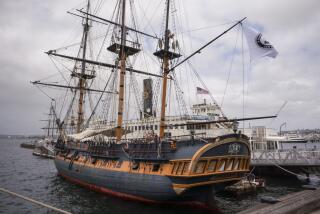Superwreck Amoco Cadiz: THE SHIPWRECK THAT HAD TO HAPPEN by Rudolph Chelminski (Morrow: $18.95; 288 pp.)
- Share via
At 9:30 on the night of March 16, 1978, the Very Large Crude Carrier (VLCC) Amoco Cadiz, fully laden with more than 100,000 tons of Arabian crude, went aground off the shore of France’s Brittany coast. Its steering gear had failed in a storm so violent that even a powerful rescue tug couldn’t keep the Cadiz off the rocks. It was impaled on a rock spire with “a great, grinding crunch,” and, as the seas broke it apart, its cargo floated out and covered the sea and the shore in the worst peacetime tanker disaster ever.
The ensuing inquiries and legal battles were bitter, and now that they are mostly settled, author Rudolph Chelminski rehashes it all for us. The first half of “Superwreck” is the gripping story of Amoco Cadiz’s final voyage. The second half deals with the aftermath. Throughout, there are plenty of less-than-admirable characters: the 35-year-old Italian ship’s captain, who kept calling his corporate bosses in Chicago instead of exercising his own authority when it might have counted; the Standard Oil executives whose penny-pinching budgets excluded proper maintenance and repair of a faulty steering gear; the Spanish manufacturers of the gear; the international lawyers who squabbled profitably over who would pay for the damage as everybody sued everybody else; French government officials who talked a good preparedness game but actually did little.
The heroes stand out: the captain of the rescue tug; a French helicopter pilot who fished the crew off the bridge of the stricken tanker in almost unflyable weather; a cool Briton aboard the tanker as a training adviser, and finally U.S. District Judge Frank McGarr, who, after weighing all the testimony and arguments, laid a large share of the responsibility on Standard Oil.
One wishes that Chelminski had been as comfortable telling the second half of the story as he was the first. Suspense runs out, especially for readers who have followed these events in the press. The author tries to keep the drama alive by larding his narrative with pejoratives instead of letting the information speak for itself--and then, when he has painted his villains an oily black, he skips away like a graffiti artist. In the end, as Chelminski’s account seems to unravel, the reader might wish the author had relied on a more coherent and informative account of the victims, both animal and human, and their struggle to survive in the wake of the disaster.
More to Read
Sign up for The Wild
We’ll help you find the best places to hike, bike and run, as well as the perfect silent spots for meditation and yoga.
You may occasionally receive promotional content from the Los Angeles Times.






